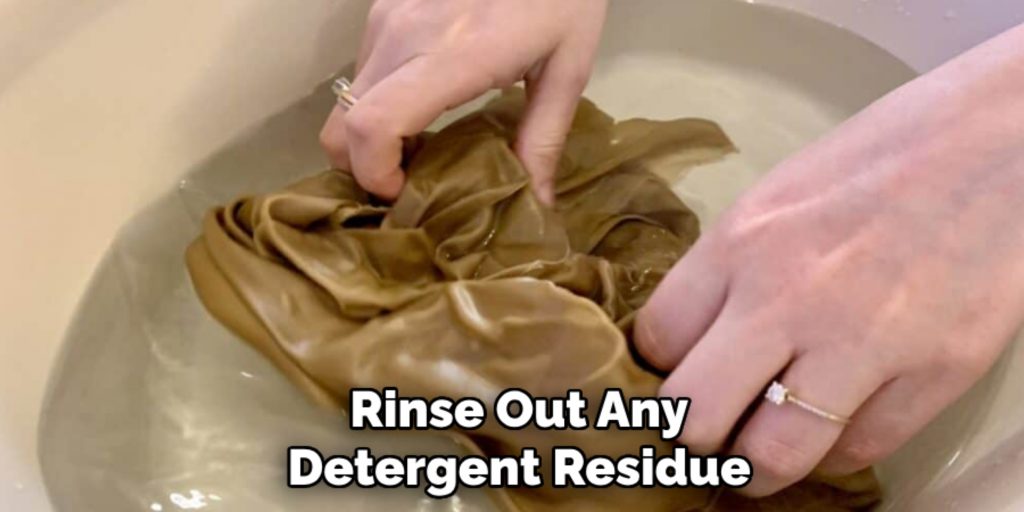Are you tired of trying different methods to wash your silk bonnet, and it still is not turning out right? Look no further, as we have the perfect guide for cleaning a silk bonnet properly.

Silk bonnets are a popular choice for protecting hair while sleeping, thanks to their smooth texture and gentle touch that reduces friction and minimizes hair damage. However, it’s crucial to clean silk bonnets correctly to maintain their softness and longevity. Washing silk requires special care to preserve its delicate fibers and avoid shrinking discoloration, or damage.
This guide on how to wash a silk bonnet will walk you through the proper steps to wash your silk bonnet safely and keep it in pristine condition. Let’s get started!
What Are the Benefits of a Silk Bonnet?
Before we dive into the washing process, let’s first discuss why silk bonnets are worth taking care of. Here are some benefits of using a silk bonnet:
- Protects Hair While Sleeping: Silk is known for its smooth texture and minimizes friction between your hair and pillowcase. This helps prevent breakage, split ends, and frizz.
- Retains Moisture in Hair: Unlike cotton or other materials that absorb moisture from hair, silk helps retain moisture, keeping your hair hydrated throughout the night.
- Reduces Tangles: The smooth surface of silk makes it easier for hair to glide over without getting tangled or knotted.
- Gentle on Skin: Silk is hypoallergenic and breathable, making it an excellent choice for sensitive skin.
These benefits make silk bonnets a must-have for anyone looking to maintain healthy hair and skin while sleeping.
What Will You Need?
Before we jump into the washing process, make sure you have the following items ready:
- Mild detergent or silk-specific cleanser
- Lukewarm water
- Sink or basin
- Soft towel
Once you have these items, let’s move on to the washing process.

10 Easy Steps on How to Wash a Silk Bonnet
Step 1: Check the Label
Before starting, it’s essential to check the care label on your silk bonnet. The label provides specific instructions on how to wash and care for the fabric to prevent damage. Look for recommendations, such as whether the bonnet is hand-washed only or can withstand machine washing.
Additionally, it may indicate the type of detergent to use and the ideal water temperature for cleaning. Following these guidelines will help maintain your silk bonnet’s texture, color, and longevity. If the label is missing or unclear, it’s safest to hand wash using a gentle detergent.
Step 2: Fill a Basin with Lukewarm Water
Add a small amount of gentle detergent specifically formulated for delicate fabrics into the basin of lukewarm water. Stir the water gently with your hand to ensure the detergent is fully dissolved and the solution is evenly mixed. Avoid using bleach or harsh chemicals, which can weaken the silk fibers and cause discoloration.
Once the detergent is fully dispersed, you are ready to submerge your silk bonnet into the soapy water. Be careful not to use hot water, as it can damage the delicate fabric and cause it to lose its silky texture.
Step 3: Add Detergent
Carefully place your silk bonnet into the prepared lukewarm, soapy water basin. Press it down to ensure it is fully submerged and soaked with the detergent solution. Avoid scrubbing or wringing the fabric, as this can lead to stretching or damaging the delicate silk fibers.
Instead, use your hands to lightly agitate the water around the bonnet for about 3-5 minutes, allowing the detergent to dissolve dirt and oils effectively. If there are any specific spots or stains, you can softly rub those areas using your fingertips, but always be gentle to preserve the integrity of the material. Once the bonnet has soaked sufficiently and looks clean, you can move on to rinsing it thoroughly.
Step 4: Soak the Bonnet
After the bonnet has soaked and been gently cleaned, it’s time to rinse out any detergent residue. Begin by draining the soapy water from your basin and replacing it with clean, lukewarm water.

Submerge the bonnet fully, and while keeping the motion gentle, swish it around in the clean water to loosen and remove any excess detergent. It’s essential to rinse the bonnet multiple times, as even small amounts of remaining detergent can affect the softness or quality of the silk over time.
Each time you rinse, check the clarity of the water. If the water still appears cloudy, repeat the process with fresh, clean water until completely clear. Instead, hold the bonnet at the edge or cup it gently in your hands to allow the water to stream out naturally. Proceed to dry promptly for best results.
Step 5: Rinse Thoroughly
Drain the soapy water from the basin and refill it with clean, lukewarm water. Carefully place your silk bonnet into the basin and press down gently to submerge it in the freshwater. Move the bonnet around in a gentle circular motion to help rinse away any remaining soap residue. Continue rinsing until there is no trace of suds left on the fabric.
Step 6: Remove Excess Water
After rinsing your silk bonnet thoroughly, it’s essential to remove excess water without causing damage to the delicate fabric. Carefully lift the bonnet out of the water, supporting it with both hands to prevent overstretching.
Avoid wringing or twisting the bonnet, as this can harm its fibers and compromise its shape. Instead, lay the bonnet flat on a clean, dry towel. Gently fold the towel over the bonnet and press down lightly to absorb the excess water. For best results, repeat this process with a second dry towel if the first becomes saturated. Ensuring most of the water is removed before drying will help maintain the bonnet’s softness and longevity.
Step 7: Air Dry Your Silk Bonnet
Air drying is the best method to preserve the quality and texture of your silk bonnet. Once you have removed the excess water using a towel, find a clean, flat surface where the bonnet can dry undisturbed. Place the bonnet on a drying rack or a clean, dry towel spread over a flat surface. Ensure the drying area is away from direct sunlight, as prolonged exposure to UV rays can fade the colors and weaken the silk fibers.

It is also essential to avoid using a tumble dryer or any direct heat source, as high temperatures can shrink or damage the delicate fabric. Allow the bonnet to dry entirely at its own pace. This typically takes several hours, depending on the humidity and airflow in your environment. Patience is key, as proper air drying helps maintain the bonnet’s natural sheen and ensures its durability for continued use.
Step 8: Iron Your Silk Bonnet
Once your silk bonnet is completely dry, you may notice slight wrinkles or creases from the washing and drying. You can use an iron set to low heat to smooth out these imperfections and restore the bonnet’s shape. Place a clean towel over the bonnet and gently run the iron over it, avoiding direct contact with the fabric.
Alternatively, you can steam your silk bonnet using a garment steamer or hanging it in a bathroom while taking a hot shower. This will help remove any remaining wrinkles and restore its natural shine.
Step 9: Add in Essential Oils
For an extra touch of luxury and to keep your silk bonnet smelling fresh, you can add a few drops of essential oils to the final rinse water. Lavender, chamomile, or rose are popular choices for their soothing scents and beneficial properties. Simply mix a few drops into the water before submerging your bonnet for the final rinse.
This will leave your silk bonnet with a subtle, pleasant aroma that can help promote relaxation and improve sleep quality when worn at night. However, make sure to test a small area first to ensure the oil does not cause any discoloration or adverse reactions on your silk fabric.
Step 10: Store Properly
Proper storage is essential to preserve the quality and longevity of your silk bonnet. After ensuring it is scorched and wrinkle-free, store it in a clean, dry space away from direct sunlight, which can fade its color and weaken the fabric over time. It’s best to keep your silk bonnet in a drawer or a designated storage box lined with tissue paper to prevent snagging. Alternatively, you can hang it on a soft, padded hanger to maintain its shape.
Avoid cramming it into tight spaces or placing heavy items on top of it, as this can cause creases or damage to the delicate material. For added protection, consider using a breathable storage bag to keep dust and moisture at bay.
By following these simple steps, you can ensure your silk bonnet remains pristine and provides you with luxurious comfort for years.

Conclusion
Silk bonnets are delicate and require special care to maintain their softness, shape, and color.
By following the steps outlined in this guide on how to wash a silk bonnet, you can effectively clean, rinse, dry, and store your silk bonnet to ensure its longevity.
Remember to be gentle during cleaning and avoid using harsh chemicals or excessive heat. With proper care and attention, your silk bonnet will continue to provide you with a comfortable and luxurious sleep experience.
Feel free to repeat these steps every few weeks to keep your silk bonnet fresh and clean for optimal use. Sweet dreams!
About the Author
Jane Hubbard is a passionate beauty expert with a wealth of experience in makeup, hair, and overall beauty techniques. After years of working as a hairdresser specialist, she followed her entrepreneurial spirit and started her own consultancy business.
Jane has always been driven by her desire to help others feel confident in their own skin, and she does this by sharing her knowledge, experiences, and practical beauty tips. Through her consultancy, she empowers individuals to embrace their unique beauty, offering tailored guidance that boosts both self-esteem and personal style.
Professional Focus
- Specializes in makeup, hairstyling, and beauty consulting.
- Provides personalized beauty advice, tips, and techniques to help individuals feel confident in their appearance.
- Dedicated to staying up-to-date with the latest industry trends and developments.
- Passionate about creating a comfortable and empowering experience for every client.
Education History
- University of Craft and Design – Bachelor of Fine Arts (BFA) in Woodworking and Furniture Design
- Woodworking Apprenticeships – Extensive hands-on training with skilled craftsmen to refine carpentry and furniture making techniques
- Online Courses & Masterclasses – Continued education in advanced woodworking techniques, design principles, and specialized tools
Expertise:
- Makeup artistry, hairstyling, and beauty consulting.
- Personalized beauty techniques to enhance confidence and self-expression.
- Educating clients on how to maintain their beauty routines at home.
